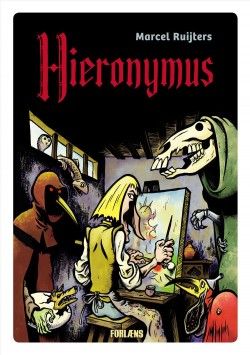Hieronymus
 Marcel Ruijters is an award winning Dutch comic artist with a fascination for medieval art, which is obvious in his own artwork. As part of the 2016 programme of festivities commemorating the 500th anniversary of the death of Hieronymus Bosch, Ruijters was commissioned by the Bosch 500 Foundation and Mondriaan Art Fund to produce a graphic book about the artist’s life.
Marcel Ruijters is an award winning Dutch comic artist with a fascination for medieval art, which is obvious in his own artwork. As part of the 2016 programme of festivities commemorating the 500th anniversary of the death of Hieronymus Bosch, Ruijters was commissioned by the Bosch 500 Foundation and Mondriaan Art Fund to produce a graphic book about the artist’s life.
The result of this commission is the graphic novel Hieronymus (English) or Jheronimus (Dutch version), a hard-covered comic arranged in five chapters and filled with phantasmagorical images recognisable from Bosch’s own art.
A history trip
Rather than a comprehensive biography, the five chapters cover various significant periods in the author’s life. The drawings add the historical context to the narrative: the role of the Church; the public hatred of the Dominican Order for their participation in the Inquisition; the 1463 fire that destroyed a considerable section of Den Bosch’s inner city buildings; and a culture that incorporated both debauchery and chronic hardships.
The story of Hieronymus is weaved through the illustrations, depicting him as the third son in a family of artists – who made a living producing artworks commissioned by the Church. As a young man he questioned his work and domestic situation, almost moving to Belgium before heeding the foreboding of a palm reader he encountered in a tavern. On his return to Den Bosch, he is confronted by serious family conflict that eventually results in his taking control of the business.
Bizarre and amazing art
Ruijters’ illustrations are difficult to describe. Often simultaneously gruesome and hilarious, especially the images of convicted criminals having their limbs chopped off and genitals mutilated in front of a jeering crowd, and under the supervision of a religious dignitary. Individual characters have unique features and expressions, an impressive feat considering the numerous crowd scenes. Background sketches of a Dutch city and surrounding countryside in the 1500s seem authentic, often including unsavory details like freak show employees and leper colonies hassling for coins.
Who was Hieronymus?
I thoroughly enjoyed this graphic ride but was left with some unanswered questions about the artist and his work. What is the actual story behind the surreal creatures in his famous triptych ‘The Garden of Earthly Delights’? Was Hieronymus having fun or mentally ill as he painted these images?
Hopefully, the flurry of activities being organised to commemorate 500 years since his death will answer them.
Ana McGinley
books@dutchnews.nl
Thank you for donating to DutchNews.nl.
We could not provide the Dutch News service, and keep it free of charge, without the generous support of our readers. Your donations allow us to report on issues you tell us matter, and provide you with a summary of the most important Dutch news each day.
Make a donation